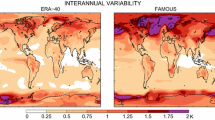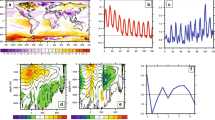Abstract
Four time-dependent greenhouse warming experiments were performed with the same global coupled atmosphere-ocean model, but with each simulation using initial conditions from different “snapshots” of the control run climate. The radiative forcing — the increase in equivalent CO2 concentrations from 1985–2035 specified in the Intergovernmental Panel on Climate Change (IPCC) scenario A — was identical in all four 50-year integrations. This approach to climate change experiments is called the Monte Carlo technique and is analogous to a similar experimental set-up used in the field of extended range weather forecasting. Despite the limitation of a very small sample size, this approach enables the estimation of both a mean response and the “between-experiment” variability, information which is not available from a single integration. The use of multiple realizations provides insights into the stability of the response, both spatially, seasonally and in terms of different climate variables. The results indicate that the time evolution of the global mean warming signal is strongly dependent on the initial state of the climate system. While the individual members of the ensemble show considerable variation in the pattern and amplitude of near-surface temperature change after 50 years, the ensemble mean climate change pattern closely resembles that obtained in a 100-year integration performed with the same model. In global mean terms, the climate change signals for near surface temperature, the hydrological cycle and sea level significantly exceed the variability among the members of the ensemble. Due to the high internal variability of the modelled climate system, the estimated detection time of the global mean temperature change signal is uncertain by at least one decade. While the ensemble mean surface temperature and sea level fields show regionally significant responses to greenhouse-gas forcing, it is not possible to identify a significant response in the precipitation and soil moisture fields, variables which are spatially noisy and characterized by large variability between the individual integrations.
Similar content being viewed by others
References
Bakan S, Chlond A, Cubasch U, Feichter J, Graf HF, Grassl H, Hasselmann K, Kirchner I, Latif M, Roeckner E, Sausen R, Schlese U, Schriever D, Schult I, Schumann U, Sielmann F, Welke W (1991) Climate response to smoke from the burning oil wells in Kuwait. Nature 351:367–371
Baumgartner A, Reichel E (1975) The world water balance: mean annual global continental and maritime precipitation, evaporation and runoff. R Oldenbourg, München-Wien
Brankovic C, Palmer TN, Molteni F, Tibaldi S, Cubasch U (1990) Extended range predictions with the ECMWF models: time lagged ensemble forecasting. Q J R Meteorol Soc 116:835–866
Cubasch U, Hasselmann K, Höck H, Maier-Reimer E, Mikolajewicz U, Sauter BD, Sausen R (1992) Time-dependent greenhouse warming computations with a coupled ocean-atmosphere model. Clim Dyn 8:55–69
Fichefet T, Tricot C (1992) Influence of the starting date of model integration on projections of greenhouse-gas-induced climatic change. Geophys Res Lett 19:1771–1774
Gloersen P, Campbell WJ (1988) Variations in the Arctic, Antarctic, and global sea ice covers during 1978 to 1987 as observed with the Nimbus 7 scanning multichannel microwave radiometer. J Geophys Res 93:10666–10674
Hansen J, Lacis A, Ruedy R (1990) Comparison of solar and other influences on long-term climate. In: Climate impact of solar variability, Conf. Publn 3086, NASA, Greenbelt, pp 149–159
Hasselmann K, Sausen R, Maier-Reimer E, Voss R (1993) On the cold start problem in transient simulations with coupled ocean-atmosphere models. Clim Dyn 9:53–61
Houghton ST, Jenkins GJ, Ephraums JJ (eds) (1990) Climate change. The IPCC scientific assessment. Cambridge University Press, Cambridge
Houghton JT, Callander BA, Varney SK (eds) (1992) Climate Change 1992. The supplementary report to the IPCC scientific assessment. Cambridge University Press, Cambridge
Livezey RE, Chen WY (1983) Statistical field significance and its determination by Monte Carlo techniques. Mon Weather Rev 111:46–59
Loewe P (1987) Sea ice simulations performed with forcing fields specified from a GCM. Techn. Rep. 6/87, Cold Regions Research Lab. 72, Hanover, New Hampshire
Lorenz EN (1975) Climatic predictability. In: The physical basis of climate and climate modelling. GARP publication series No. 16, WMO Geneva, pp 132–137
Lorenz EN (1984) Irregularity: a fundamental property of the atmosphere. Tellus 36A:98–110
Lorenz EN (1991) Chaos, spontaneous climatic variations and detection of the greenhouse effect. In: Schlesinger M (ed) Greenhouse-gas-induced climatic change: a critical appraisal of simulations and observations. Elsevier, Amsterdam, pp 445–453
Maier-Reimer E, Mikolajewicz U, Hasselmann K (1993) Mean circulation of the Hamburg LSG OGCM and its sensitivity of the thermohaline surface forcing. J Phys Oceanogr 23:731–757
Manabe S, Spelman MJ, Stouffer RJ (1992) Transient responses of a coupled ocean-atmosphere model for gradual changes of atmospheric CO2. Part 11: seasonal response. J Clim 5:105–126
Mikolajewicz U, Maier-Reimer E (1990) Internal secular variability in an ocean circulation model. Clim Dyn 4:145–156
Mikolajewicz U, Santer BD, Maier-Reimer E (1990) Ocean response to greenhouse warming. Nature 354:589–593
Mitchell JFB, Ingram WJ (1992) On CO2 and climate: mechanisms of changes in cloud. J Clim 5:5–21
Molteni F, Cubasch U, Tibaldi S (1988) 30- and 60-day forecast experiments with the ECMWF spectral models. In: Chargas C, Puppi G (eds) Persistent meteo-oceanographic anomalies and teleconnections. Pontif Acad Sci Scripta Varia, MCMLXXXVIII, 505–555
Murphy JM (1992) A prediction of the transient response of climate. Climate Research Technical Note 32, Hadley Centre, Bracknell, UK
Parkinson CA (1991) Interannual variability of the spatial distribution of sea ice in the North Pole region. J Geophys Res 96:4791–4801
Parkinson CA (1992) Interannual variability of monthly southern ocean sea ice distributions. J Geophys Res 97:5349–5363
Parkinson CA, Bindschadler RA (1984) Response of Antarctic sea ice to uniform atmospheric temperature increases. Geophys Monogr Am Geophys Union 29:254–264
Santer BD, Brüggemann W, Cubasch U, Hasselmann K, Höck H, Maier-Reimer E, Mikolajewicz U (1993a) Signal-to-noise analysis of time-dependent greenhouse warming experiments. Part 1. Pattern analysis. Clim Dyn 9:267–285
Santer BD, Cubasch U, Mikolajewicz U, Hegerl G (1993b) The use of general circulation models in detecting climate change induced by greenhouse gases. PCMDI Report No. 10, Program for Climate Model Diagnosis and Intercomparison, Lawrence Livermore National Laboratory, Livermore
Sausen R, Barthel K, Hasselmann K (1988) Coupled ocean-atmosphere models with flux correction. Clim Dyn 2:154–163
Storch H (1982) A remark on Chervin-Schneider's algorithm to test significance of climate experiments with GCMs. J Atmos Sci 39:187–189
Stouffer RJ, Manabe S, Bryan K (1989) Interhemispheric asymmetry in climate response to a gradual increase of atmospheric CO2. Nature 342:660–662
Stössel A, Lemke P, Owens WB (1990) Coupled sea ice-mixed layer simulations for the Southern Ocean. J Geophys Res 95:9539–9555
Washington WM, Meehl GA (1989) Climate sensitivity due to increased CO2: experiments with a coupled atmosphere and ocean general circulation model. Clim Dyn 4:1–38
Wigley TML, Raper SCB (1990) Natural variability of the climate system and detection of the greenhouse effect. Nature 344:324–327
Wigley TML, Santer BD (1990) Statistical comparison of spatial fields in model validation, perturbation and predictability experiments. J Geophys Res 95:851–865
Zebiak SE, Cane MA (1987) A Model El Niño-Southern Oscillation, Mon Weather Rev 115:2262–2278
Zwally HJ, Comiso JC, Parkinson CL, Carsey FD, Campbell WJ, Gloersen P (1983) Antarctic sea ice 1973–1976: satellite passive-microwave observations, NASA Spec Publ SP-459:1206
Author information
Authors and Affiliations
Rights and permissions
About this article
Cite this article
Cubasch, U., Santer, B.D., Hellbach, A. et al. Monte Carlo climate change forecasts with a global coupled ocean-atmosphere model. Climate Dynamics 10, 1–19 (1994). https://doi.org/10.1007/BF00210333
Received:
Accepted:
Issue Date:
DOI: https://doi.org/10.1007/BF00210333




